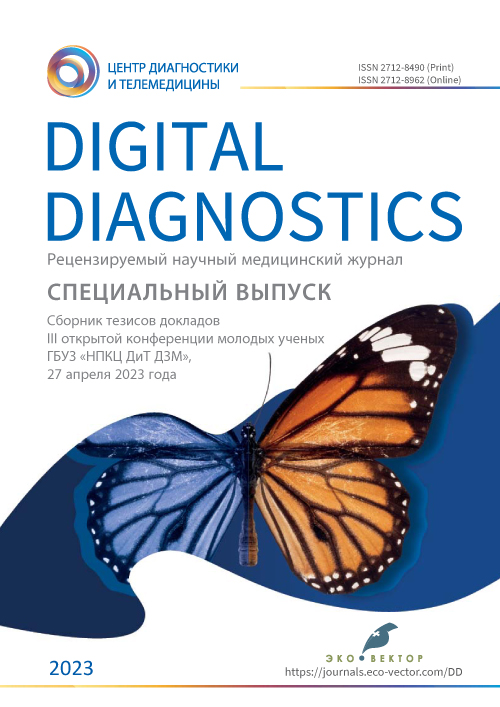Correlations and age-related changes in central and peripheral hemodynamic parameters
- Autores: Andreeva I.V.1, Grigorev A.S.1
-
Afiliações:
- Ryazan State Medical University named after Academician I.P. Pavlov
- Edição: Volume 4, Nº 1S (2023)
- Páginas: 9-10
- Seção: Conference proceedings
- ##submission.dateSubmitted##: 18.05.2023
- ##submission.dateAccepted##: 18.05.2023
- ##submission.datePublished##: 26.06.2023
- URL: https://jdigitaldiagnostics.com/DD/article/view/430328
- DOI: https://doi.org/10.17816/DD430328
- ID: 430328
Citar
Texto integral
Resumo
BACKGROUND: One of the current issues of fundamental and clinical medicine is the early diagnosis of pathological changes that may lead to the development of cardiovascular disease.
AIM: The study aimed to investigate age-related changes in the cardiovascular system in healthy individuals by a comprehensive assessment of the correlations between hemodynamic and microcirculatory parameters at different age.
METHODS: The study was conducted on 136 adult volunteers with no clinical or laboratory manifestations of cardiovascular disease. The material was divided into five age groups: adolescence, I and II periods of adulthood, old age, and senile age. Males and females accounted for 50.73% and 49.27%, respectively. Central and peripheral hemodynamic parameters were measured using high-resolution compression oscillometry, ultrasound duplex scanning of aortic arch branches, echocardiography, and reactive hyperemia test on the brachial artery. Microcirculation indices in the skin of the right index finger were studied using a laser Doppler flowmeter before and after the treadmill test. The digital data were processed by the methods of variation statistics using the JASP 0.16.4.0 statistical software package.
RESULTS: An age-related decrease in skin microcirculation indices was observed. A significant statistical dependence of changes in microcirculation indices after physical activity in the groups of old and senile age was found. Left ventricular ejection fraction, cardiac output, cardiac index, stroke volume, and stroke index progressively decreased with increasing age; diastolic blood pressure increased; pliability of the brachial artery vascular wall decreased; total and specific peripheral resistance increased. Blood flow indices in the common carotid arteries (diameter and linear and volumetric blood flow velocity) decreased, whereas resistance index and intima-media thickness increased. Blood flow indices in vertebral arteries (linear and volumetric blood flow velocity) and indices of total blood flow to the brain progressively decreased with age. In addition, the dependence of some indices on gender was revealed.
CONCLUSIONS: With increasing age in healthy people, changes in central and peripheral hemodynamic parameters occur, which do not lead to cardiovascular diseases. Age-related changes in macro- and microcirculation are best detected during functional stress tests and should be considered in clinical practice as a manifestation of the normal aging process.
Palavras-chave
Texto integral
BACKGROUND: One of the current issues of fundamental and clinical medicine is the early diagnosis of pathological changes that may lead to the development of cardiovascular disease.
AIM: The study aimed to investigate age-related changes in the cardiovascular system in healthy individuals by a comprehensive assessment of the correlations between hemodynamic and microcirculatory parameters at different age.
METHODS: The study was conducted on 136 adult volunteers with no clinical or laboratory manifestations of cardiovascular disease. The material was divided into five age groups: adolescence, I and II periods of adulthood, old age, and senile age. Males and females accounted for 50.73% and 49.27%, respectively. Central and peripheral hemodynamic parameters were measured using high-resolution compression oscillometry, ultrasound duplex scanning of aortic arch branches, echocardiography, and reactive hyperemia test on the brachial artery. Microcirculation indices in the skin of the right index finger were studied using a laser Doppler flowmeter before and after the treadmill test. The digital data were processed by the methods of variation statistics using the JASP 0.16.4.0 statistical software package.
RESULTS: An age-related decrease in skin microcirculation indices was observed. A significant statistical dependence of changes in microcirculation indices after physical activity in the groups of old and senile age was found. Left ventricular ejection fraction, cardiac output, cardiac index, stroke volume, and stroke index progressively decreased with increasing age; diastolic blood pressure increased; pliability of the brachial artery vascular wall decreased; total and specific peripheral resistance increased. Blood flow indices in the common carotid arteries (diameter and linear and volumetric blood flow velocity) decreased, whereas resistance index and intima-media thickness increased. Blood flow indices in vertebral arteries (linear and volumetric blood flow velocity) and indices of total blood flow to the brain progressively decreased with age. In addition, the dependence of some indices on gender was revealed.
CONCLUSIONS: With increasing age in healthy people, changes in central and peripheral hemodynamic parameters occur, which do not lead to cardiovascular diseases. Age-related changes in macro- and microcirculation are best detected during functional stress tests and should be considered in clinical practice as a manifestation of the normal aging process.
Sobre autores
Irina Andreeva
Ryazan State Medical University named after Academician I.P. Pavlov
Autor responsável pela correspondência
Email: prof.andreeva.irina.2012@yandex.ru
ORCID ID: 0000-0001-6946-3036
Rússia, Ryazan
Alexey Grigorev
Ryazan State Medical University named after Academician I.P. Pavlov
Email: aleksey130379@yandex.ru
ORCID ID: 0000-0001-8730-7635
Rússia, Ryazan
Bibliografia
- Rotar’ OP, Tolkunova KM. EVA and SUPERNOVA concepts of vascular aging: ongoing research on damaging and protective risk factors. Arterial’naya gipertenziya. 2020;26(2):133–145. (In Russ).
- Nilsson PM. Early Vascular Aging in Hypertension. Frontiers in Cardiovascular Medicine. 2020;7:1–5.
Arquivos suplementares











